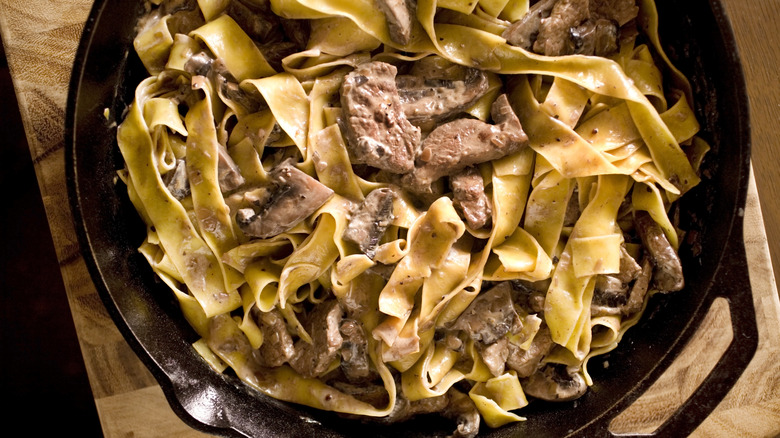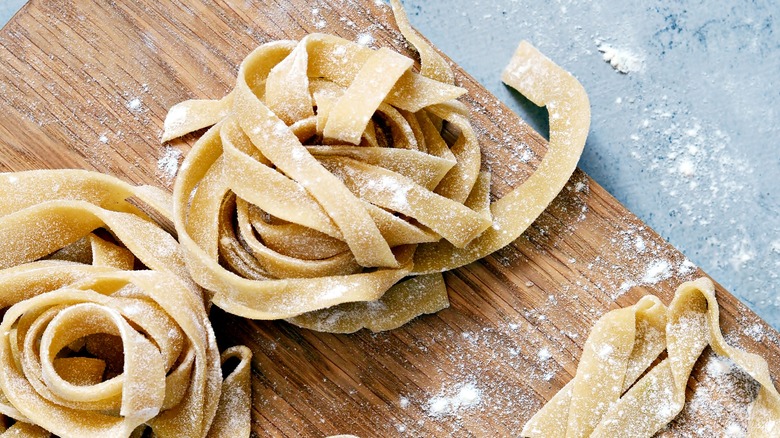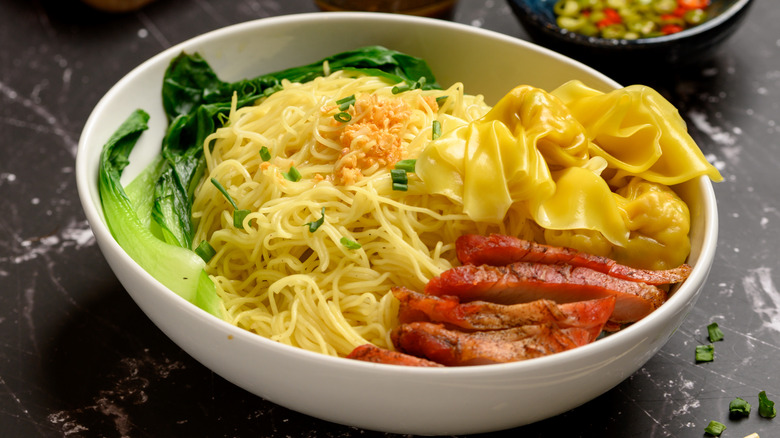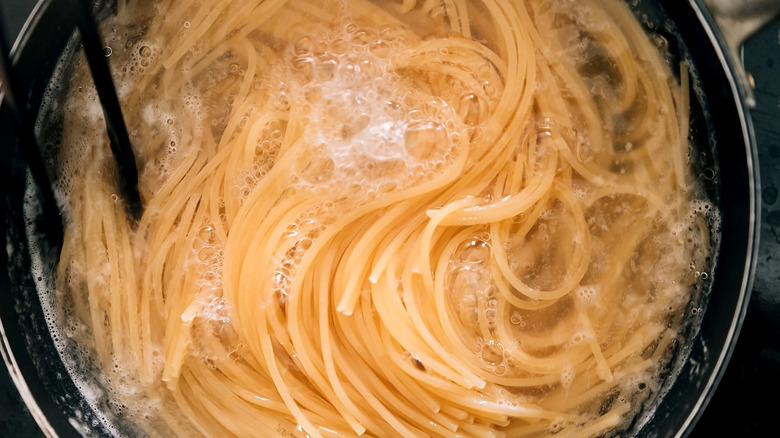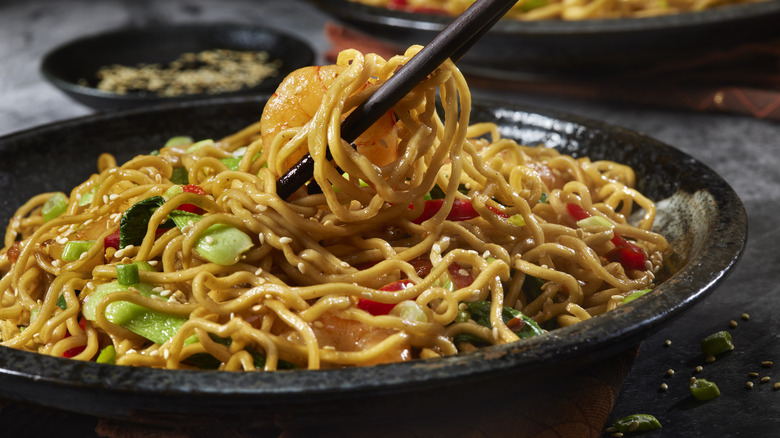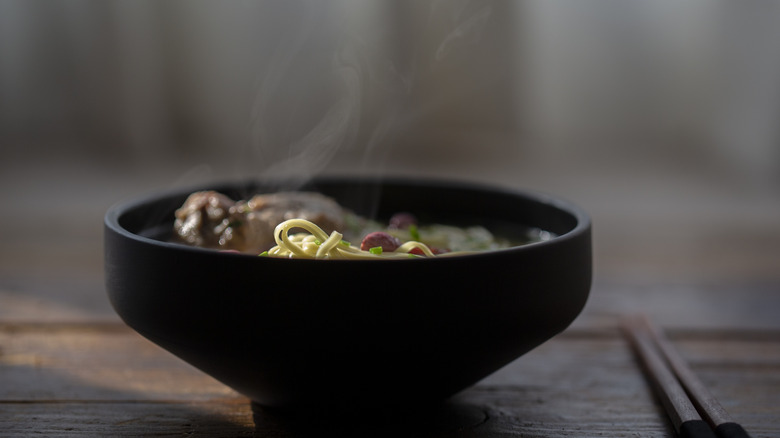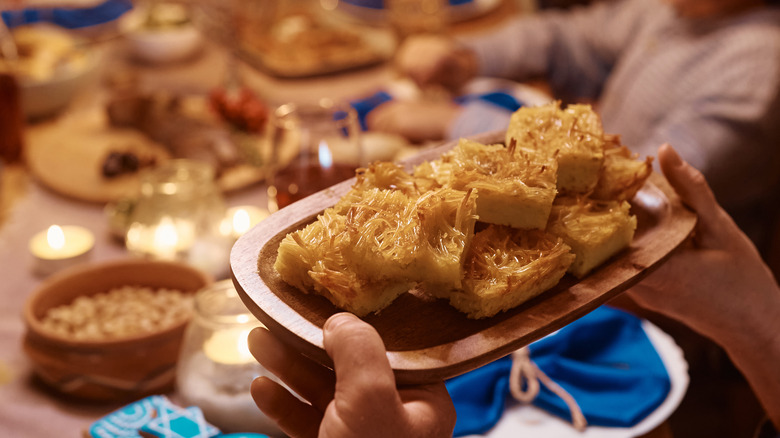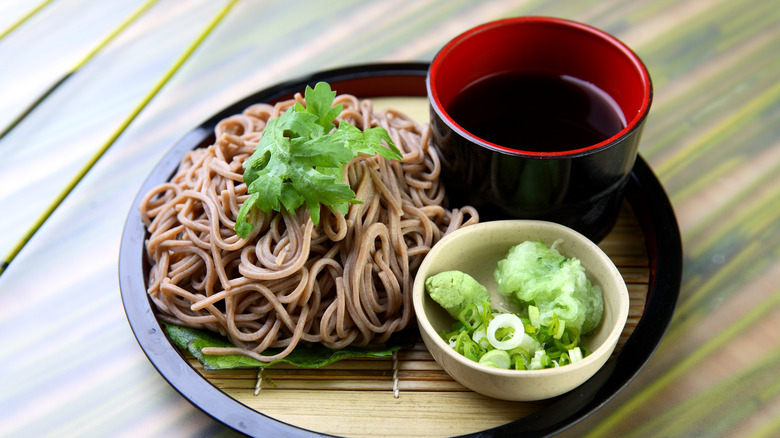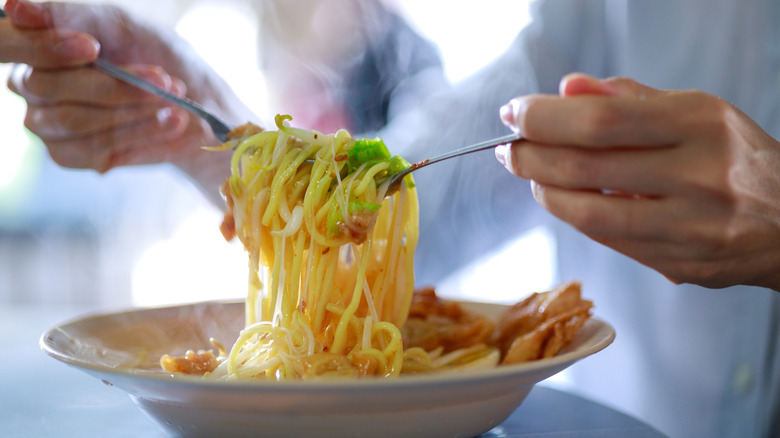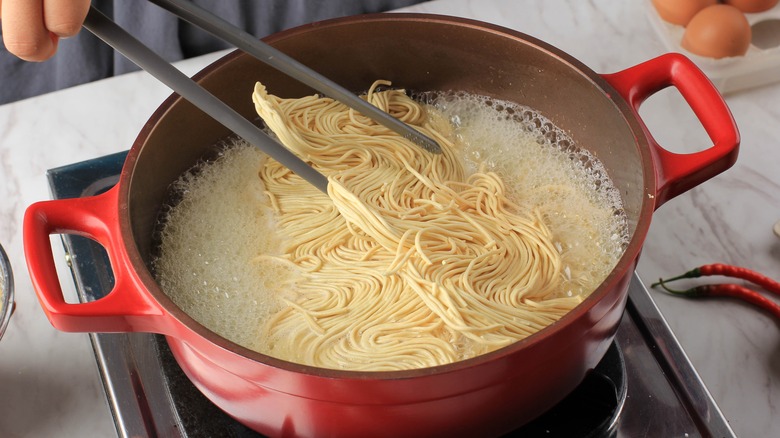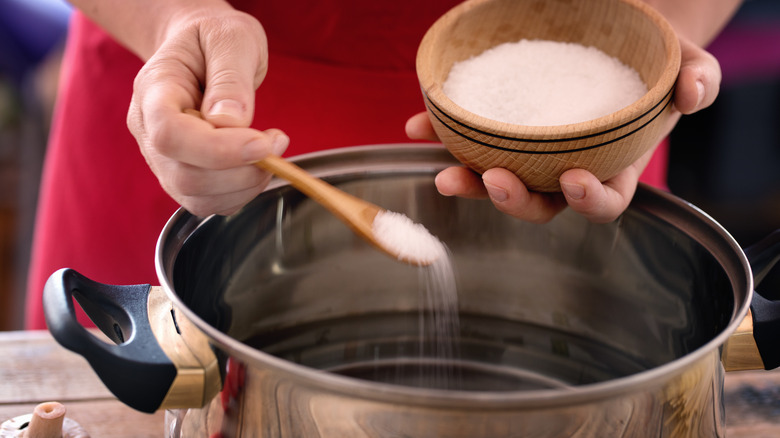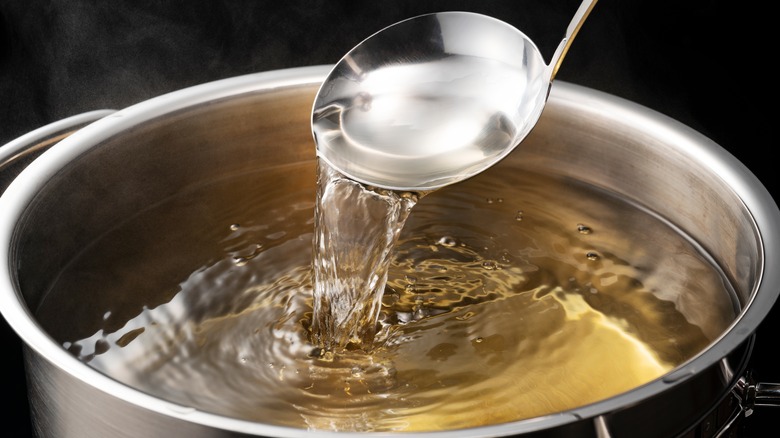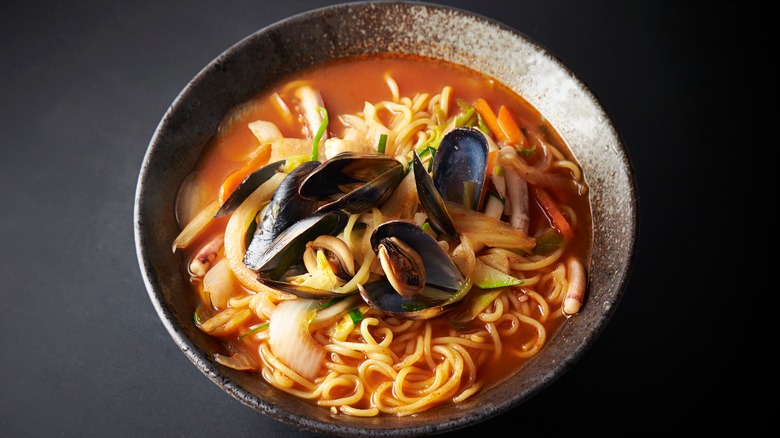13 Tips You Need When Cooking With Egg Noodles
Whether you find yourself fondly reminiscing about your grandmother's savory chicken noodle soup or the first time you mastered a creamy stroganoff, egg noodles have probably played a starring role in the creation. They're a staple in many people's cupboards and can be used for a variety of different types of dishes, including stir-fries, pastas, soups, and salads.
However, as with most ingredients, mastering the art of cooking with egg noodles can promote your dishes from good (or, ahem, bad) to excellent. And sometimes it's the small details that make all the difference. If you've ever wondered how to achieve that perfect egg noodle texture, cook a certain type of egg noodle dish, or even store egg noodles for another day, you're in the right place. Our tips for cooking with egg noodles and let your experience go from a comforting familiarity to an epicurean extravaganza. You'll find a mixture of essential, must-know tips along with some more creative advice. The question is, what egg noodle dish will you concoct next?
1. Make your own
Imagine the satisfaction of crafting delicious, fresh egg noodles yourself and serving them to your eagerly waiting friends and family. How proud would you be? Creating your own egg noodles allows you to customize them to your exact liking when it comes to the flavor, texture, and quality of ingredients. Plus, homemade noodles aren't full of preservatives and additives that are commonly found lurking in store-bought versions, offering a much healthier, fresher, and delicious alternative.
When it comes to creating your egg noodles, achieving the right dough consistency is key. It's a tender balance between ensuring the dough isn't too sticky or too dry. If you're having problems, a generous dusting of flour and the rhythmic kneading of your hands should smooth out its texture. Once they're ready, if you're not planning to use the fresh noodles immediately, let them air-dry for future feasts before storing them in an air-tight container.
2. Beware of expiration dates
Remember, egg noodles come with an expiration date, whether fresh or dry. Typically, fresh egg noodles remain safe and tasty for about four to five days past their labeled expiration date. They require timely consumption to fully enjoy their true essence. The longer shelf life of dry egg noodles makes them pretty low-maintenance, and you can keep them tucked away in a cool, dark nook for quite some time. Properly stored at room temperature, dry noodles will remain at their best quality for around two years.
If you opt for fresh noodles (typically found cozied up in the refrigerator section of stores), seal them in an air-tight container. Pop them in your fridge and plan to use them within the next few days. But, should life's unpredictability halt your noodle plans, wrap them in aluminum foil and place them in your freezer. This extends their life by several weeks. When you're ready for your next noodle feast, let them thaw in your refrigerator overnight.
3. Consider the thickness
At first glance, the thickness of an egg noodle might seem purely aesthetic and a matter of personal preference. But the thickness of your egg noodles can significantly influence how your dish turns out.The girth of your egg noodles determines key factors in the cooking process, from boiling time to sauce adherence.
Thinner noodles cook more quickly, requiring only a few minutes in boiling water to achieve that ideal al dente texture. Meanwhile, their thicker counterparts need a bit more patience to ensure they're thoroughly cooked without that sticky, doughy center.Thin noodles are delicate and often complement light, brothy dishes like soups as they can absorb flavors quickly. On the other hand, thicker noodles, with their robust structure, are champions at holding onto richer, creamier sauces, such as those in pasta dishes.
Do you feel like tucking into a light summer salad or a hearty chicken fettuccine alfredo? Make sure to choose your noodle thickness accordingly. If you create homemade egg noodles from scratch, the rolling process gives you control over the thickness. Experiment with different thicknesses to discover your personal preference.
4. Use a large pot and olive oil to prevent them from sticking together
Haven't we all, at some point, faced the disappointment of clumpy, stuck-together noodles? Sometimes, it can even feel like the entire meal has been ruined. Fear not, dear cook. The solution is simple and lies in two kitchen superheroes: a generously sized pot and a large splash of olive oil.
When they hit the boiling water, egg noodles expand and dance around, searching for space. A small, cramped pot can hinder this movement, leading to an uneven cook. A large, spacious pot ensures that the noodles have ample water to cook in and enough room to move freely, preventing those unwanted sticky situations.
A drizzle of olive oil in your boiling water can also work wonders. It not only helps prevent the noodles from sticking to each other but also lends a slight richness, ensuring that each strand is beautifully glossed and flavored. The olive oil also acts as a protective layer, stopping the noodles from adhering to the base of the pot. Alternatively, running olive oil over the egg noodles after draining them can also help separate them.
5. Cook al dente for stir-fries
The cooking world is rife with phrases that may sound mysterious but often carry profound wisdom. Al dente, an Italian term translating to "to the tooth," is one such phrase that's seemingly become a golden standard for pasta and noodle cooking. And when it comes to stir-frying egg noodles, achieving that perfect al dente texture is recommended for many types of dishes — especially stir-fries.
Stir-fries blend textures and flavors, including crisp vegetables, succulent meats, and savory sauces. When egg noodles join the party, cooking them al dente ensures they have a slight bite, holding their own amidst the ensemble. Likewise, stir-fry dishes often involve cooking noodles twice — first boiled, then stir-fried. Al dente noodles, being slightly undercooked, have the resilience to withstand the stir-fry process without turning mushy. They can absorb the sauces beautifully while retaining their chewy character.
To achieve the magic of al dente, boil your egg noodles a minute or two less than the package's recommendation. Many products will actually highlight how long to cook for al dente. They should be tender but with a slight firmness in the center. Once tossed into the sizzling wok or pan, they'll continue to cook, absorbing the flavors while keeping their shape. Remember, al dente isn't about undercooking. It's about precision. It's attempting to capture that fleeting moment when the noodle is neither too hard nor soft but just right.
6. Add to soups at the end of the cooking time
Introducing egg noodles into a heartwarming soup can elevate the dish to new heights. But timing, as they say in both cooking and life, is everything. To ensure that your egg noodles complement rather than compromise your soup, it's essential to add them towards the end of your cooking session.
With their delicate composition, egg noodles can quickly absorb liquids and become overly soft. Adding them too early in the soup-making process might lead to a soggy, gooey outcome, losing that satisfying bite. Adding noodles to the soup later ensures they retain their texture, infusing the soup with just the right amount of chewiness. Plus, a well-timed addition means your noodles soak up the rich flavors of the broth at the right time. They become little carriers of taste, delivering the essence of your soup in every bite (or slurp).
Once your soup is nearly ready and brimming with all its taste, that's your cue. Plop in the egg noodles and let them simmer until they're perfectly al dente. This way, they're cooked just enough to achieve the desired texture and flavor infusion. Think of your egg noodles as the finale of a grand performance. Their late entrance ensures they shine brilliantly, rounding off your soup. So, the next time you're stirring a pot of soul-soothing soup, remember to let your egg noodles make their timely, triumphant addition.
7. Experiment with stir-fries, soups, salads, and more
The beauty of egg noodles lies not just in their taste but also in their incredible versatility. Why limit them to one genre of cooking when they can excel across a spectrum?
Stir fries are a classic choice, allowing egg noodles to intertwine with vibrant veggies, tender meats, and aromatic sauces. The slightly chewy texture of the noodles balances the crunch of fresh vegetables. As we've just discussed, introducing egg noodles towards the end of your soup-making process ensures they soak up the broth's flavors without losing their bite. They transform a simple broth into a hearty, filling meal that's ideal served in the colder fall and winter months.
Cold egg noodle salads, teamed with zesty dressings and combined with crunchy veggies or grilled meats, are refreshing, especially during the longer spring and summer days. They're perfect for sunshine-bathed picnics or light dinners. Then there are casseroles, where egg noodles are layered with creamy sauces and baked. And desserts — yes, desserts! — where sweetened egg noodles pair with the likes of fruits, custards, and spices for an unusual yet delicious treat.
Whether it's the sizzle of a wok, the simmer of a soup pot, or the freshness of a salad bowl, there are plenty of egg noodle dishes to experiment with. Let your imagination run wild and see where these versatile noodles take you.
8. Drain under cool water for cold noodle dishes
Noodles have traditionally been savored warm, nestled in soups or stir-fries. But did you know that egg noodles can be great in cold dishes too? From flavor-packed Asian-inspired salads to refreshing Mediterranean pastas, there are plenty of ways to enjoy egg noodles chilled. But how do you ensure those egg noodles retain their allure when cooled?
Enter the trick of draining egg noodles under cool water. Egg noodles are naturally starchy, and while this starchiness can be fantastic in hot dishes, it can be a bit of a bother in cold plates, causing noodles to stick together in unappetizing clumps. Draining egg noodles under cool water immediately after boiling not only stops the cooking process but also rinses away the excess starch, ensuring they stay separate and silky.
There's a lovely al dente quality that we desire in cold noodle dishes — a bite that contrasts beautifully with crunchy veggies or tender proteins. Cool water helps retain that texture while preserving the noodle's flavor. A cold noodle dish often involves a tantalizing dressing, be it tangy, sweet, or spicy. Noodles rinsed in cold water are more receptive, absorbing these flavors better, making every mouthful a burst of taste sensations.
9. But skip the rinse for hot dishes
If you're adding egg noodles directly to a hot dish or sauce, skip the rinse. The starch released from egg noodles while they cook, while rinsed away for cold dishes, is an asset in hot preparations. Why? Because it helps make sauces cling to each noodle, amplifying flavors and textures. Whether you're whipping up a velvety tagliatelle or a spicy penne arrabbiata, the starchy surface of unrinsed noodles helps thicken the sauce, making it coat each noodle evenly.
Traditional noodle dishes from many cultures often rely on the starchy quality of noodles to achieve their signature tastes and textures. Therefore, rinsing could mean deviating from an authentic recipe or experience. Likewise, rinsing hot noodles in cool water can drop their temperature drastically. Serving immediately after draining ensures they're piping hot, adding to the comfort and warmth of the dish. Going straight from the pot to the plate ensures that your noodles deliver their full potential in taste, texture, and temperature.
10. Get the timing right when boiling
If not quite cooked right, egg noodles can either have an unwelcome harsh bite or a tendency to disintegrate. Getting them 'just right' isn't mere luck – it's all about timing. Once you pop your noodles into boiling water, the magic starts quickly. A typical cooking span of egg noodles is around 5 minutes, but as always, trust your senses over the clock. A simple bite test can be your best guide.
Let the noodles simmer a tad longer if they still offer too much resistance. Start taste testing after four minutes. If they still feel too firm, give them another two minutes, keeping a watchful eye. A crucial thing to note is the sneaky "carry-over" cooking. Even after being removed from their hot bath, egg noodles continue to cook, courtesy of the retained heat, so always consider this extra time.
And remember, it all comes down to personal preferences. Do you love your noodles al dente, with a slight bite? Or do you prefer a softer, suppler texture? Keep this in mind when cooking your noodles.
11. Always salt the water
When it comes to cooking egg noodles, one tiny detail packs a significant punch: salting the water. Imagine tucking into a plate of egg noodles, expecting a burst of flavors, only to be met with a bland taste. Salting the boiling water is like setting a foundation for your egg noodles. It enhances the original flavor of the noodles, ensuring they're delicious even before adding any sauce or accompaniments.
Salting the water isn't just about making the noodles 'salty'. It's about amplifying the noodles' natural taste and creating a canvas where every ingredient can shine brighter. In short, it's like giving your dish a little head start. But while salting is crucial, there's a fine line between 'just right' and 'the Dead Sea.' A general guideline is to add about 1 tablespoon of salt per 4 quarts of water, but feel free to adjust to your taste. If you're testing, the water should taste like mild seawater. And another benefit is that salt works double duty. Apart from seasoning, it raises the boiling point of water, allowing the noodles to cook slightly faster and more evenly.
12. Boil in broth for extra flavor
Want to significantly amp the flavor of your egg noodles before even mixing in a sauce? While boiling salted water provides a promising canvas when cooking, a broth infuses the noodles with a depth of flavor from the get-go.
Chicken, beef, vegetable, or even seafood broth — the choice is yours. The key is to match the broth with the dish you're creating. Making a chicken stir-fry? Chicken broth is probably the no-brainer. Crafting a seafood pasta dish? A light seafood broth can elevate the taste.
Be cautious about adding extra salt when cooking your egg noodles in broth. Many broths, especially store-bought varieties, are already packed with sodium. It's wise to taste and adjust the seasoning only if necessary for a balanced flavor. This tip doesn't stop at boiling. If you have leftover broth after cooking the noodles, don't toss it. It carries a rich noodle essence and can be a fantastic base for sauces or soups you'll be cooking shortly.
13. Dress quickly after draining
When draining pasta, time is of the essence. Freshly drained noodles are like sponges, ready to absorb. The warm, porous strands are primed to latch onto flavors. This is your golden window to introduce your choice of sauce or dressing, allowing it to combine beautifully with the noodles. Left undressed, noodles can cling together. A quick dressing not only infuses flavor but also acts as a barrier, preventing the noodles from turning into a clumpy mass. That silken, individual strand texture? It's retained.
When it comes to sauces and dressings, the options are seemingly endless. There's everything from a simple light olive oil and garlic dressing to a zesty Asian-inspired soy and sesame mix. Ensure you have your chosen sauce ready to envelop those steaming noodles as soon as they're drained.
As we've mentioned, if you're creating a cold noodle dish, a brief rinse of the noodles under cold water post-draining can halt the cooking process. Once cooled, promptly introduce your dressing to maximize flavor absorption.
